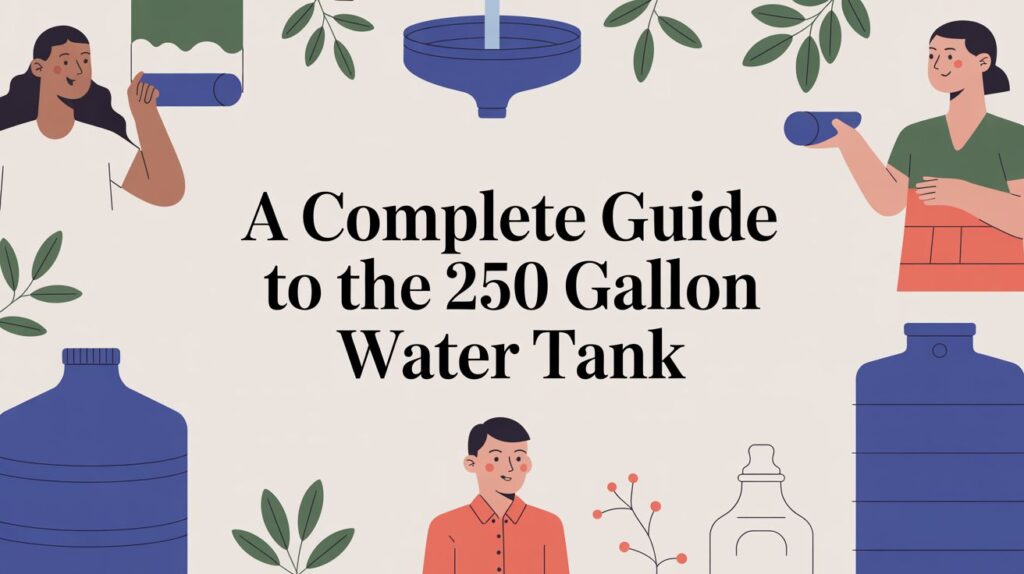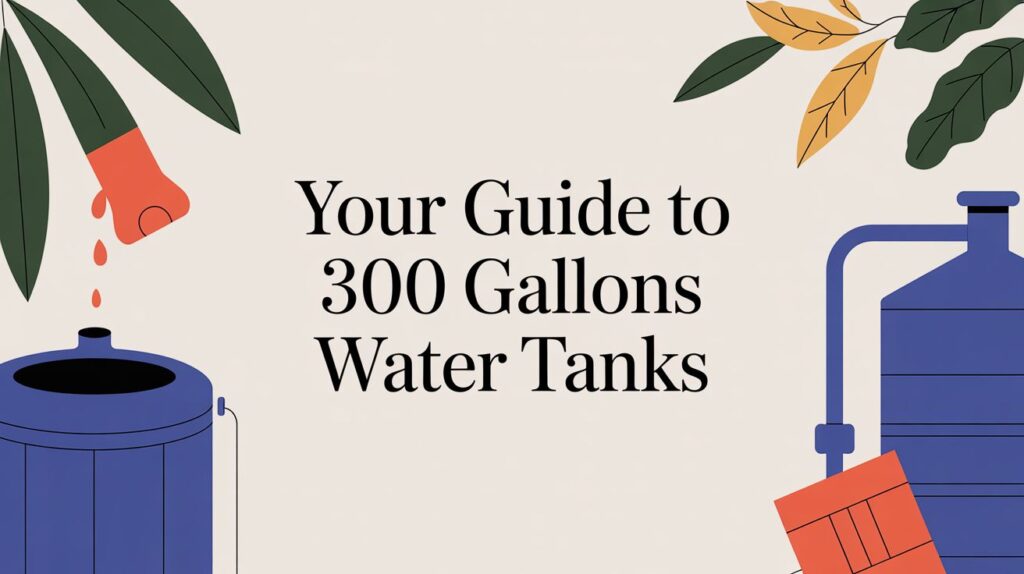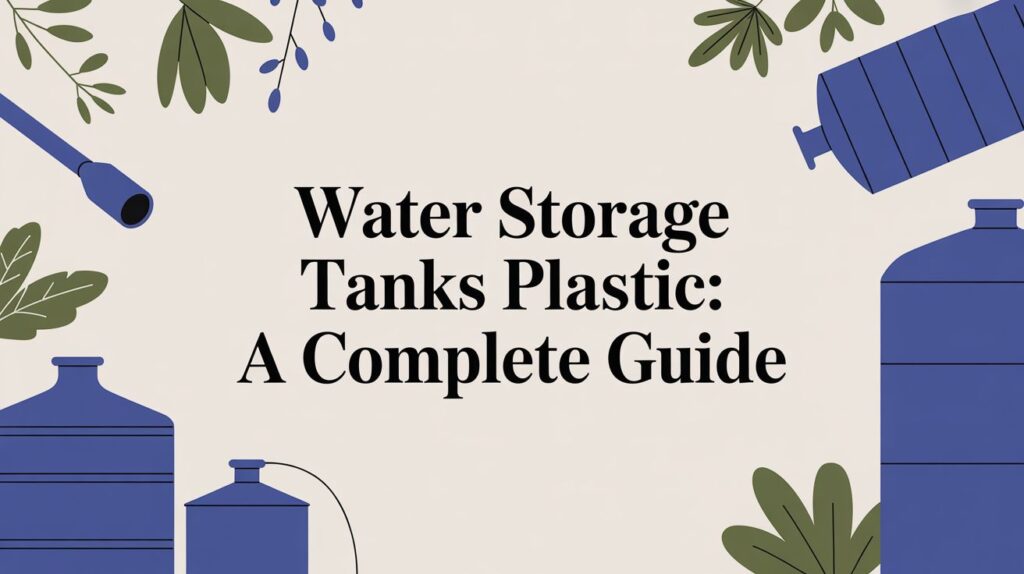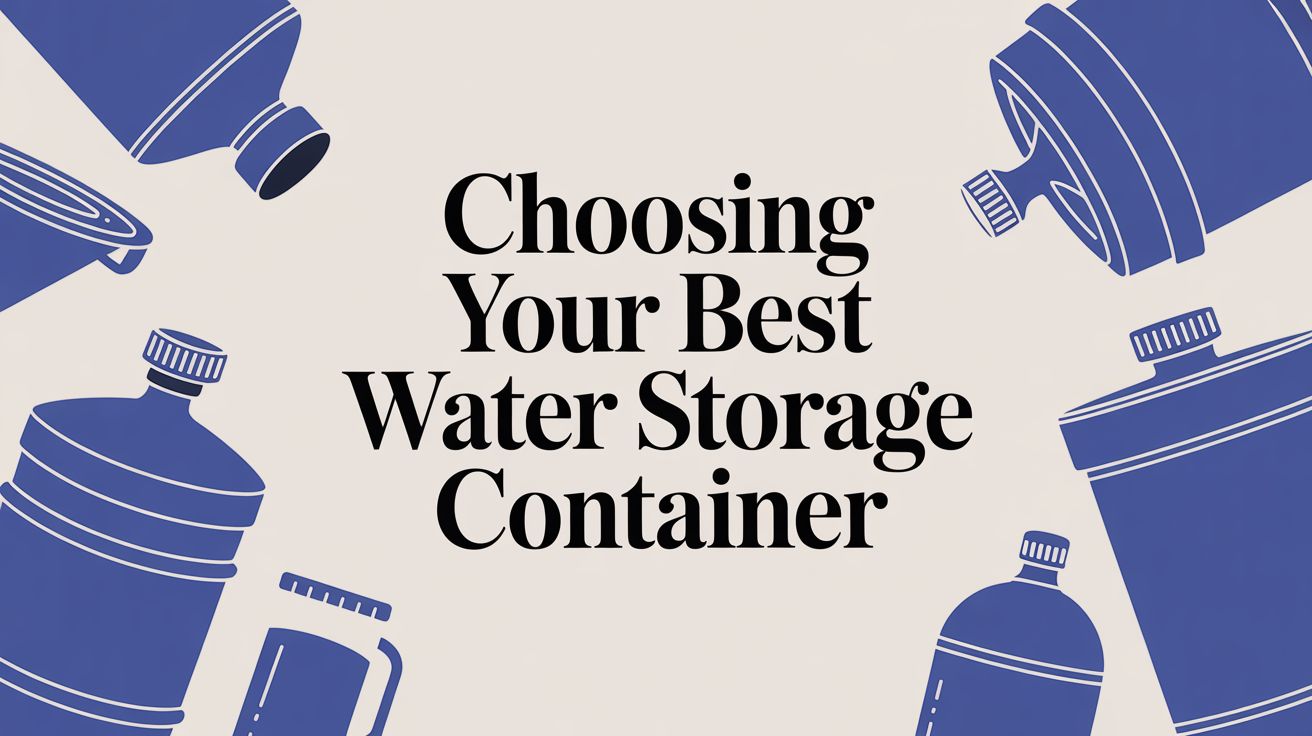
Choosing Your Best Water Storage Container
Having a good water storage container is one of the most important things you can do to secure a safe water supply for your home, farm, or business. It’s not just about having a big tank; it’s about making sure your water stays clean, easy to get to, and ready when you need it—whether for an emergency, collecting rainwater, or for daily use in farming or industry.
Getting the basics right, like choosing food-grade materials and the appropriate capacity, is the foundation of a system that will actually work for you.
Why Your Choice of Water Container Matters
Securing a reliable source of water is a fundamental part of being prepared, whether you’re a homeowner or running a business. It’s the practical step you take to get ready for a water main break, a long drought, or simply needing water on a part of your property that isn’t connected to the grid. The decision is much bigger than just buying the largest tank you can find. It’s a careful balancing act between the safety of the material, how much it can hold, and where you’re going to put it.
Think of it like this: choosing a water container is like planning a key piece of your property’s infrastructure. Get it right, and you’ve bought yourself years of peace of mind. Get it wrong, and you could be dealing with contaminated water, frustrating leaks, or a setup that just doesn’t do what you need it to. A well-chosen container is a real investment in your independence and ability to keep things running smoothly.
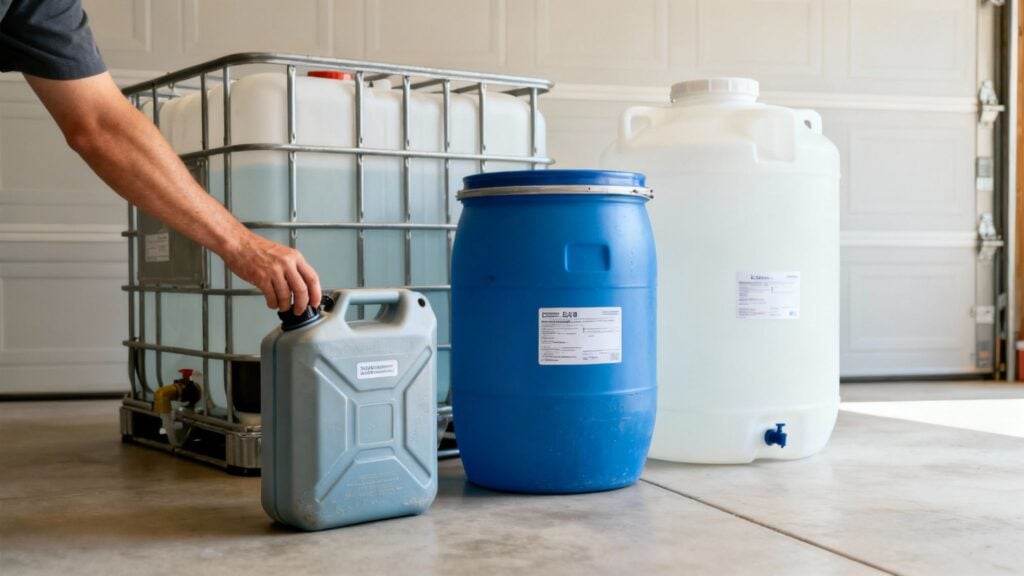
From Personal Prep to Community Resilience
Water storage isn’t just for one person or one family. On a bigger scale, smart water management is critical for entire communities, especially in places that see a lot of dry weather.
Just look at how large states manage their water. In California, for example, the amount of water stored underground is vastly more than what’s in all its surface reservoirs. The state’s groundwater basins can hold somewhere between 850 million and 1.3 billion acre-feet. To put that in perspective, all of its major reservoirs combined only hold about 50 million acre-feet. You can read more on this massive large-scale water storage comparison at Stanford.edu.
That same idea applies right down to your own property. A good water storage system acts as your personal buffer against the unknown, putting you in control of one of your most essential resources.
Your water storage system is your personal reservoir. It protects against unforeseen shortages and empowers you with greater independence, whether you’re supporting a family, a farm, or a business operation.
Key Factors to Consider Early On
Before you start looking at specific tanks and containers, take a moment to map out what you really need. Getting clear on your goals from the start will make every other decision, from the type of plastic to the kind of valve you need, much simpler.
- Primary Use: What’s the water for? Is it for drinking, watering the garden, for livestock, or for an industrial use? This will tell you what kind of safety ratings to look for.
- Required Volume: How much water do you actually need on hand? This will depend on the size of your family, how much you need to irrigate, or your business’s daily demand.
- Available Space: Where are you going to put the container? The amount of ground space and height you have will naturally narrow down your options.
- Climate Conditions: Will the tank be sitting in direct, intense sun or in a place where it could freeze? This will determine if you need UV-resistant materials or even a heater.
Answering these questions first will get you heading in the right direction and make finding the perfect water storage container for your situation a whole lot easier.
Matching Container Materials to Your Needs
Choosing the right material for your water storage container is one of the most important decisions you’ll make. Think of it like picking the right tool for a job—using the wrong one can lead to all sorts of headaches, from contaminated water to a tank that just doesn’t last. The material is the foundation of everything; it dictates the water’s safety, how long the container will hold up, and what it’s going to cost you.
It helps to think about the scale of your needs. A small, portable drum is like a compact car, perfect for an emergency kit or a quick job. But a massive polyethylene tank? That’s your heavy-duty truck, built for the long haul and big volumes, like a whole-house rainwater system or farm irrigation. The material is what defines its purpose.
The Gold Standard: High-Density Polyethylene
For most people, especially when storing drinking water, High-Density Polyethylene (HDPE) is the go-to material, and for good reason. This isn’t just any old plastic. It’s a specific type known for being incredibly tough, impact-resistant, and chemically stable. That’s why everything from milk jugs to massive industrial tanks are made from it.
One of the biggest selling points for HDPE is that it doesn’t leach nasty chemicals into your water. When you see a container advertised as BPA-free, chances are it’s made from high-quality, virgin HDPE. This peace of mind is crucial, ensuring the water you store stays just as pure as the day you filled it. If you want to see what’s out there, you can explore a range of durable plastic water storage tanks to get a feel for the different designs made from HDPE.
On top of that, many HDPE tanks come with built-in UV inhibitors. This is a special additive that protects the plastic from getting brittle and breaking down under the sun’s harsh rays—a must-have for any container that will live outdoors. This simple feature can dramatically extend the life of your investment.
Exploring Other Material Options
While HDPE is a fantastic all-rounder, other materials fill specific niches and are worth a look depending on what you’re doing. Each has its own pros and cons when it comes to cost, durability, and weight.
- Steel Tanks: Usually galvanized or lined, steel tanks are incredibly strong and can last for decades. They’re a popular choice for large-scale fire suppression or agricultural systems, but they are much heavier and pricier than plastic.
- Fibreglass Tanks: Also known as fibreglass-reinforced plastic (FRP), these tanks won’t rust and can be built to enormous sizes. You’ll often see them in industrial or municipal settings, but they can be prone to cracking from a hard knock.
- Concrete Tanks: These are often built right on-site, sometimes underground, and they do a great job of keeping water cool. The downside is that they can mess with the water’s pH if they aren’t sealed properly, and they are by far the most permanent and labour-intensive option.
Choosing the right material really comes down to balancing your priorities. For drinking water, always stick with food-grade, UV-stabilized HDPE. But if you need massive, non-potable storage, the structural advantages of steel or fibreglass might be a better fit.
Thinking big isn’t just for individuals. In response to ongoing droughts, the Metropolitan Water District of Southern California has boosted its storage capacity an incredible 13 times over the last 30 years by using a mix of reservoirs and underground water banking. It’s a great example of how different storage strategies work together on a massive scale.
A Quick Comparison of Common Materials
To make things a bit clearer, here’s a simple table that breaks down the trade-offs between the most common materials you’ll find.
Water Storage Container Material Comparison
| Material | Key Advantages | Key Disadvantages | Best For |
|---|---|---|---|
| HDPE Plastic | Lightweight, affordable, rust-proof, often food-grade and UV-resistant. | Can be damaged by sharp impacts; quality varies by manufacturer. | Potable water, rainwater harvesting, general home and farm use. |
| Galvanized Steel | Extremely durable, long lifespan, fire-resistant. | Heavy, more expensive, can rust if coating is compromised. | Large-scale irrigation, livestock water, fire suppression systems. |
| Fibreglass (FRP) | Corrosion-resistant, can be made in very large sizes, good for chemical storage. | Can be brittle, more expensive than plastic, potential for fibre contamination if damaged. | Industrial use, chemical storage, large custom water systems. |
At the end of the day, your choice of material boils down to what you plan to use the water for. By understanding these fundamental differences, you can pick a container that will give you safe, reliable service for years to come.
Understanding Food Grade and Safety Ratings
When you’re storing water that people will actually drink, safety is everything. You can’t just grab any old container. The codes and labels stamped on a tank are your roadmap to choosing the right one, and learning to read them is crucial.
Think about it—you wouldn’t store drinking water in a container that once held motor oil, right? The same logic applies here. Plastics and metals can hold onto residues or leach chemicals you don’t want in your water. Choosing a container with the proper safety ratings is the only way to be certain your water stays clean and safe.
What “Food Grade” Really Means
The most important term to look for is food-grade. This isn’t just a marketing buzzword; it’s a certification. It means the container’s material—usually brand-new, virgin High-Density Polyethylene (HDPE)—is safe for direct contact with anything people are going to eat or drink.
Food-grade plastics are made under very strict guidelines. They contain no sketchy recycled materials, no harmful dyes, and no other contaminants that could sneak into your water. This is non-negotiable for drinking water storage.
Key Takeaway: If a container isn’t clearly marked as “food-grade” or “potable water safe,” just assume it isn’t. It’s not worth the risk to your health.
This certification is your guarantee that the plastic itself won’t taint the taste or smell of your water or, worse, add harmful chemicals. It’s the absolute baseline for a safe drinking water system. If you’re building a system from scratch, looking at pre-vetted potable water storage tanks is a great way to start with confidence.
What About Transport Ratings?
Beyond food safety, you’ll often see other codes on containers like IBC totes and drums. These are usually about how tough the container is, which is another great sign of quality.
The most common ones are UN/DOT ratings. These aren’t about food safety directly. Instead, they certify that a container is strong enough to handle being shipped and handled, even when filled with hazardous materials.
- UN (United Nations): An international standard showing the container has passed tough tests for strength, pressure, and impact.
- DOT (Department of Transportation): The North American equivalent, often found alongside the UN rating.
Now, you’re not hauling around dangerous chemicals, but a UN/DOT rating on a water storage container is fantastic news. It means the tank is built like a beast—incredibly durable and resistant to leaks and cracks. That’s exactly the kind of reliability you want for long-term storage, even if the tank never leaves your property.
How to Spot a Safe Container
When you’re looking at a tank, the proof is usually moulded right into the plastic or printed on a permanent label. Here’s a quick checklist of what to look for:
- The #2 Recycling Symbol: This is a dead giveaway that the plastic is HDPE, which is the gold standard for potable water.
- Food-Safe Icons: Look for a little cup and fork symbol. It’s the universal sign that a material is safe for food contact.
- Clear Statements: The manufacturer’s description should clearly state things like “food-grade,” “potable water safe,” or “BPA-Free.”
Once you know how to spot these simple markers, you can confidently tell the difference between a tank built for drinking water and one that’s only good for industrial fluids. This little bit of knowledge can save you from a very costly—and potentially dangerous—mistake.
Comparing IBC Totes, Drums, and Poly Tanks
When you start looking at serious water storage, you’ll find three options pop up again and again: Intermediate Bulk Containers (IBCs), the classic 55-gallon drums, and those big polyethylene tanks. Each has its own place, and picking the right one means looking at how much you need to store, how much space you have, and how you plan to use the water. It’s not about just grabbing the biggest or cheapest container; it’s about matching the tank to the job.
Let’s think of it like picking a vehicle. A 55-gallon drum is your trusty cargo van—it’s compact, does the job well, and you can add more vans if you need to scale up. An IBC tote is more like a versatile utility truck, already kitted out with a protective cage and a valve, ready to work from day one. And a massive poly tank? That’s the industrial semi-trailer, built for one thing and one thing only: hauling the absolute biggest volume possible.
The All-Rounder: IBC Totes
There’s a good reason why IBC totes are so popular. They hit that sweet spot between a huge capacity—usually 275 or 330 gallons—and a design that’s incredibly practical right out of the gate. The inner plastic bottle is made from tough HDPE, and it’s surrounded by a metal cage that protects it from bumps and scrapes, making it perfect for a worksite or just sitting in your backyard.
That cage also means you can easily move it around with a pallet jack or forklift, which is a massive plus for farms or businesses. The real clincher, though, is the built-in valve at the bottom. You can get water out without having to rig up a pump or siphon. Whether you’re setting up a rainwater harvesting system or storing water for livestock, an IBC is pretty much a plug-and-play solution. Their cube shape is also remarkably efficient for the space they take up. To get a feel for their size, you can check out different IBC tote measurements and see how one might fit into your plan.
The Classic: 55-Gallon Drums
The 55-gallon drum is the original workhorse of bulk storage. You’ll find them in either steel or HDPE plastic, and their biggest advantage is their manageable size. You can start small with just one or two and simply add more as your needs grow. This makes them a fantastic choice for homeowners building up an emergency water supply or for businesses that don’t have a lot of extra space.
Their standard round shape means they can be tucked into corners or lined up neatly. And while one drum doesn’t hold a ton of water, a bank of them can add up to a serious reserve. The main trade-off is convenience; they don’t come with a spigot, so you’ll need a separate pump or a simple siphon to access the water inside.
The Heavy Hitter: High-Capacity Poly Tanks
When you need to store water by the thousands of gallons, nothing beats a large polyethylene tank. These are the giants of the water storage world. They’re the go-to for whole-home rainwater collection, large-scale farm irrigation, or even commercial fire suppression systems. The sizes are staggering, ranging from a few hundred gallons all the way up to 10,000 gallons or more.
Unlike IBCs or drums, these tanks are meant to be permanent fixtures. They’re built from UV-stabilized, food-grade plastic to ensure the water stays safe and the tank itself can withstand years of sun exposure. Their sheer volume offers a level of water security that smaller containers just can’t touch, making them a real investment in long-term preparedness.
The choice really boils down to a simple trade-off. Drums give you flexibility to scale, IBCs offer all-in-one convenience, and poly tanks deliver pure, unadulterated volume. The best water storage container for you is the one that strikes the right balance for your space and budget.
This decision tree infographic is a great starting point, showing the first critical question you need to ask.
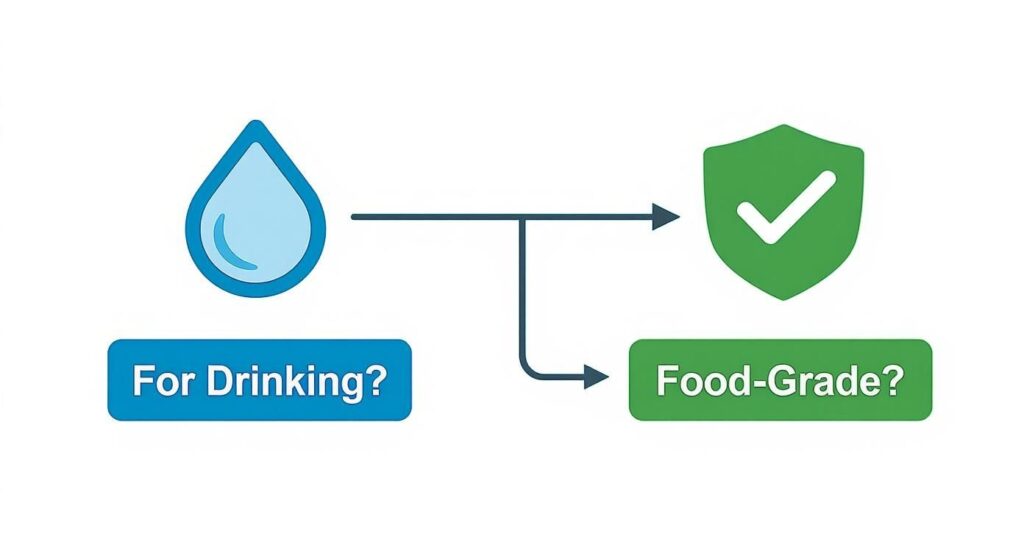
As you can see, if drinking water is the goal, making sure the container is food-grade is the non-negotiable first step.
Head-to-Head Comparison
To make things even clearer, let’s put them side-by-side.
- Capacity: Drums are your smallest option at ~55 gallons. IBCs hold the middle ground at 275-330 gallons. Poly tanks are the undisputed champs, starting around 500 gallons and going up to 10,000+ gallons.
- Convenience: IBCs win this one, hands down. The cage and built-in valve mean they’re ready for immediate use. Drums need extra gear to get water out, and large poly tanks often require professional installation.
- Footprint: For the most water in the smallest area, the cube shape of an IBC is tough to beat. Drums can be packed in tight, but a big cylindrical poly tank will take up a significant amount of ground space.
- Cost per Gallon: As a general rule, the bigger you go, the cheaper the storage gets per gallon. A giant poly tank is a big upfront cost but is often the most economical for huge volumes. Rebottled IBCs offer an excellent, budget-friendly middle ground.
In the end, it all comes back to your specific needs. If you want a few hundred gallons in an easy-to-use package, an IBC tote is probably your best bet. If you’re short on space or want to start small and grow, drums offer great flexibility. And if you’re serious about long-term, large-scale water storage, nothing beats the capacity of a dedicated poly tank.
Taking Care of Your Gear: Essential Maintenance and Accessories
Think of your water storage container less like a simple box and more like a complete system. To keep it working properly and your water safe, a little bit of upkeep and the right parts are non-negotiable. This isn’t just about protecting your investment; it’s about making sure your water is clean, easy to get to, and ready when you need it most.
Just like your car needs regular oil changes to run smoothly, your tank needs some routine care and the right accessories to perform reliably for years to come.
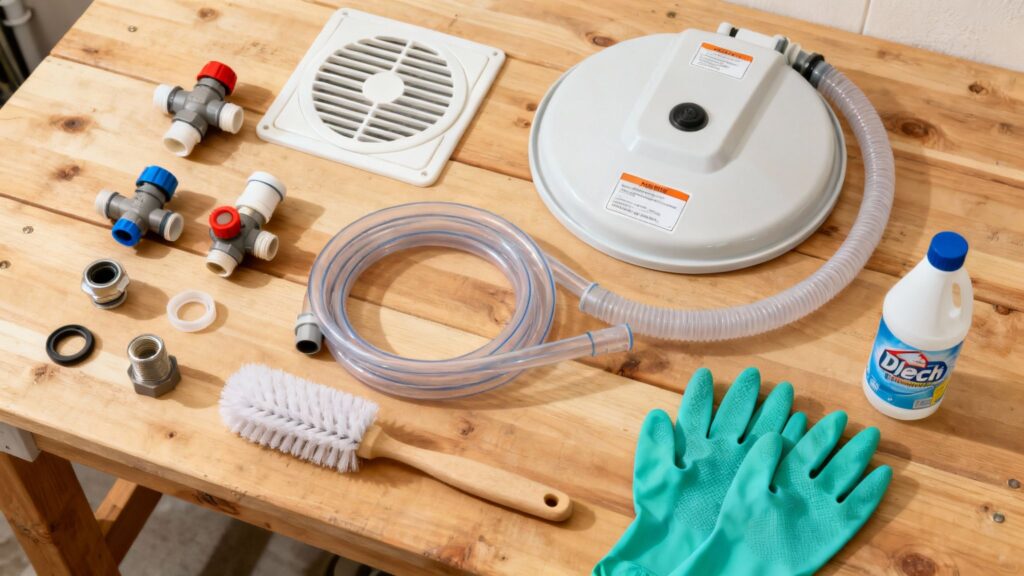
Routine Cleaning and Sanitisation
Even a sealed container, especially one that gets some sunlight, can eventually become a home for algae and bacteria. The single most important thing you can do to keep your water fresh and safe is to clean your tank regularly.
If you’re storing potable water, plan on a full sanitisation cycle at least once a year. You should also do one anytime you notice a slimy feel inside or a bit of an off-odour. It’s a straightforward process that gets rid of any harmful microorganisms.
Here’s a simple, field-tested method for sanitising your water storage container:
- Empty and Scrub: First, drain the tank completely. Get in there with a brush and a basic soap solution to give the interior walls and floor a good scrub. You want to remove any sediment or that thin, slick layer of biofilm.
- Rinse Thoroughly: Use a hose or a pressure washer to rinse out every last bit of soap. Keep going until the water running out is perfectly clear.
- Sanitise with Bleach: Mix up a sanitising solution with some plain, unscented household bleach. A good rule of thumb is about 5 ml of bleach for every 4 litres of water.
- Let It Sit: Fill the tank back up with your bleach solution. Make sure it touches all the interior surfaces, then let it stand for at least four to six hours to do its work.
- Final Drain and Air Dry: Drain the bleach water, give it one final rinse, and then open the lid to let it air dry completely before you fill it up again.
Choosing the Right Valves and Fittings
The valve is the part of your container you’ll use the most, so getting a durable, compatible one is key. Most IBC totes, for example, come with a standard buttress thread valve. That’s great, but you’ll almost certainly need an adapter to connect a regular garden hose or pump.
Think of adapters as the universal translators for your plumbing. They’re what let you seamlessly connect different thread types, like the buttress threads on the tank and the NPT (National Pipe Thread) common on pumps and spigots.
I can’t stress this enough: have the right adapters on hand before you need them. It will save you a world of headaches. A simple camlock fitting, for instance, can make hooking up a pump a quick, tool-free job, saving you a ton of time and frustration.
A few common accessories you’ll probably need:
- Buttress to NPT Adapters: These are essential for connecting standard North American plumbing fittings.
- Garden Hose Adapters: A must-have for simple tasks like filling watering cans or attaching a hose.
- Camlock Fittings: Perfect for quick-connect and disconnect setups with larger pumps and industrial hoses.
- Replacement Lids and Caps: Lids get lost or damaged. Having a spare ensures you can always maintain a tight seal to keep bugs and debris out.
Climate Control for Your Container
Where you live makes a huge difference in what extra gear you might need. The two biggest threats from Mother Nature are intense sun and freezing temperatures.
If you’re in a colder part of the country, stopping your water from freezing is absolutely critical. Water expands by about 9% when it freezes, and that force is powerful enough to crack even the toughest plastic or steel tank. A tank heater is the simplest fix. These are either submersible or wrap-around devices that keep the water just above freezing—usually around 5.6°C (42°F)—so it stays liquid and your container stays in one piece.
On a similar note, a vented lid is a small part that does a big job. As you drain water, air needs to get in to replace it; otherwise, you create a vacuum that can cause the tank walls to collapse inward. A good lid has a vent built right in to handle this pressure exchange automatically. Managing water at scale is a constant challenge, even for government systems. For instance, California’s major reservoirs currently hold water at about 105% of the historical average, which really shows the importance of maintaining capacity. You can see more about California’s reservoir levels at Engaging Data.
Making a Smart Purchase
You’ve done the homework on materials, types, and all the necessary bits and pieces. Now for the final step: actually getting your hands on the right water storage container without any nasty surprises. This is where the rubber meets the road, and a bit of practical planning goes a long way.
The goal here is to find the best overall value, which isn’t just about the initial price tag. Think about the total cost—from browsing online to getting the tank settled in its final spot. A “cheap” tank that costs a fortune to ship or needs a bunch of expensive adapters can quickly turn into a real headache. A little foresight at this stage makes sure your investment is a good one from day one.
New, Used, or Rebottled Containers?
As you start looking, you’ll see containers fall into three main buckets. Knowing the difference is crucial for making a choice that’s both safe and budget-friendly.
- Brand New: This is your safest bet, no question, especially if you’re storing water for drinking. A new, food-grade container gives you total peace of mind and usually comes with a manufacturer’s warranty. You know for certain it’s never held anything else.
- Used (Reconditioned): These are tanks that have had a previous life storing something else before being professionally cleaned. While they’re easy on the wallet, they are never a good idea for drinking water. You just can’t be 100% sure all contaminants are gone. They are, however, a solid choice for things like garden irrigation or collecting rainwater for non-potable uses.
- Rebottled: This is a clever middle-ground, particularly for IBC totes. You get a used and inspected steel cage, but the part that actually holds the water—the inner plastic bottle—is brand new and food-grade. It’s a great way to get a pristine, safe container for potable water without paying the full “brand new” price.
When it comes to water for people or animals, the choice is simple: go with either a brand new or a rebottled container. The potential health risks from a used tank just aren’t worth the few dollars you might save upfront.
Local Pickup Versus Freight Shipping
So, you’ve picked your tank. How do you get it home? For a smaller drum, you can probably just toss it in the back of a truck. But for a hefty IBC tote or a big poly tank, you need a solid game plan.
Finding a local supplier for your water storage container is usually the easiest and most cost-effective route. You can often drive over and pick it up yourself, completely sidestepping those hefty shipping fees. It also gives you the big advantage of seeing the container with your own eyes before you hand over any money.
But sometimes, you just can’t find what you need locally. Maybe you need a specific UN/DOT rating or a unique size. That’s when freight shipping comes into the picture. It will add to the final cost, but it opens up a world of options from suppliers across the country. Just be ready for delivery day. You’ll need a clear path for a big truck and a way to get the tank off it—think a forklift or a tractor with forks. A little planning here will save you a major scramble when the driver arrives.
Frequently Asked Questions
Got a few last questions before you decide? You’re not alone. Let’s tackle some of the most common things people ask when choosing and setting up their water storage containers.
How Do I Clean a New Container for Drinking Water?
Even a brand-new, food-grade container needs a good clean before you fill it up with drinking water. This is just a simple, two-step precaution to wash away any dust from manufacturing or shipping and make sure the inside is completely sanitary.
Start by giving the tank a thorough rinse with fresh, clean water. Then, mix up a simple sanitising solution: about one teaspoon of unscented household bleach for every four litres of water. Pour that into the container, seal it up, and give it a good shake or roll it around to make sure the solution coats every single interior surface.
Let it sit for at least 30 minutes, then drain it completely. The final step is to let it air dry with the lid off before filling it with your fresh drinking water.
What Is a Rebottled IBC Tote?
Think of a ‘rebottled’ IBC tote as the best of both worlds—it’s a smart hybrid that balances cost and quality perfectly. You get a used, inspected, and perfectly functional steel cage on the outside, but on the inside, you get a brand-new, never-used inner plastic bottle (or bladder).
This makes them a fantastic, budget-friendly option for storing potable water. Because the part that actually touches your water is fresh from the factory and certified food-grade, you’re getting the same safety as a completely new IBC, just without the brand-new price tag.
A quick pro tip: When buying a rebottled tote for drinking water, always confirm the new inner bottle is certified as food-grade. It’s a crucial detail for ensuring the water is safe for people or animals.
Can I Use a Standard Rain Barrel for Drinking Water?
I’d strongly advise against it, at least not without some serious filtration and purification first. Rainwater seems pure, but the water that lands in a typical rain barrel has run all over your roof first.
Just think about what’s up there—bird droppings, particles from your shingles, dust, and whatever else the wind blows on. To make that water safe to drink, you’d need to run it through a sediment filter to get the gunk out, and then treat it with chlorine or a UV steriliser to kill any nasty bacteria or viruses. It’s not as simple as just collecting and drinking.
At IBC Tanks Canada, we’ve got a huge selection of both new and rebottled water storage solutions ready to go. You can find the right container for any job by checking out our full range at https://ibctanks.ca.

